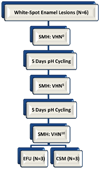In vitro remineralization of human and bovine white-spot enamel lesions by NaF dentifrices: A pilot study
- PMID: 21643437
- PMCID: PMC3105352
In vitro remineralization of human and bovine white-spot enamel lesions by NaF dentifrices: A pilot study
Abstract
The aim of this feasibility study was to evaluate the in vitro remineralization effects of four dentifrice systems using microhardness and fluoride uptake analyses. In vitro testing for the potential remineralization of the white-spot lesions in bovine and human enamel was performed using a 10-day pH cycling model. The study involved the following NaF silica-based dentifrices: 1) placebo (0 ppm F), 2) 500 ppm F, 3) 1150 ppm F, and 4) 500 ppm F plus functionalized tricalcium phosphate (fTCP). Each day consisted of four two-minute treatments, one four-hour acid challenge (pH = 5.0), and immersion in artificial saliva (pH = 7.0) between these events. After cycling, specimens were analyzed for surface microhardness (SMH), enamel fluoride uptake (EFU), and cross-sectional microhardness (CSM). Statistical analyses revealed significant differences (ANOVA, LSD, p<0.05) among the four groups, with the placebo and 500 ppm F dentifrices providing significantly less remineralization relative to the 1150 ppm F and 500 ppm F plus fTCP dentifrices. Notably, while CSM measurements for both enamel types generated similar profiles for the four groups, SMH and EFU revealed human enamel was more sensitive to the 500 ppm F dentifrice groups compared to bovine enamel. This apparent sensitivity may be due to the inherent structural differences between the two substrates.
Figures



Similar articles
-
In situ remineralization of white-spot enamel lesions by 500 and 1,100 ppm F dentifrices.Clin Oral Investig. 2012 Aug;16(4):1007-14. doi: 10.1007/s00784-011-0591-2. Epub 2011 Jul 13. Clin Oral Investig. 2012. PMID: 21750917 Clinical Trial.
-
Evaluation of different fluoridated dentifrice formulations using an in situ erosion remineralization model.J Clin Dent. 2009;20(6):192-8. J Clin Dent. 2009. PMID: 20131679 Clinical Trial.
-
Laboratory assessment of the anticaries potential of a new dentifrice.J Clin Dent. 2009;20(2):45-9. J Clin Dent. 2009. PMID: 19591336
-
Surface microhardness changes, enamel fluoride uptake, and fluoride availability from commercial toothpastes.J Clin Dent. 2006;17(4):94-9. J Clin Dent. 2006. PMID: 17131711
-
Remineralisation of carious lesions and fluoride uptake by enamel exposed to various fluoride dentifrices in vitro.Oral Health Prev Dent. 2013;11(3):281-90. doi: 10.3290/j.ohpd.a30170. Oral Health Prev Dent. 2013. PMID: 23878839
Cited by
-
Evaluation to determine the caries remineralization potential of three dentifrices: An in vitro study.J Conserv Dent. 2013 Jul;16(4):375-9. doi: 10.4103/0972-0707.114347. J Conserv Dent. 2013. PMID: 23956545 Free PMC article.
-
Synthesis of plate-like β-tricalcium phosphate nanoparticles and their efficiency in remineralization of incipient enamel caries.Prog Biomater. 2019 Dec;8(4):261-276. doi: 10.1007/s40204-019-00126-y. Epub 2019 Dec 7. Prog Biomater. 2019. PMID: 31813116 Free PMC article.
-
Comparative Evaluation of the Remineralizing Potential of Commercially Available Agents on Artificially Demineralized Human Enamel: An In vitro Study.Contemp Clin Dent. 2019 Oct-Dec;10(4):605-613. doi: 10.4103/ccd.ccd_679_18. Contemp Clin Dent. 2019. PMID: 32792818 Free PMC article.
-
An In Vitro Evaluation of Remineralization Potential of Functionalized Tricalcium Phosphate Paste and CPP-ACPF on Artificial White Spot Lesion in Primary and Permanent Enamel.Int J Clin Pediatr Dent. 2020 Nov-Dec;13(6):579-584. doi: 10.5005/jp-journals-10005-1813. Int J Clin Pediatr Dent. 2020. PMID: 33976478 Free PMC article.
-
Comparison of various concentrations of tricalcium phosphate nanoparticles on mechanical properties and remineralization of fissure sealants.J Dent (Tehran). 2014 Jul;11(4):379-88. Epub 2014 Jul 31. J Dent (Tehran). 2014. PMID: 25584048 Free PMC article.
References
-
- Arends J, Jongebloed WL. Crystallite dimensions of enamel. J. Biol. Buccale. 1978;6:161–171. - PubMed
-
- Bachmann L, Diebolder R, Hibst R, Zezell DM. Infrared absorption bands of enamel and dentin tissues from human and bovine teeth. Appl. Spectrosc. Rev. 2003;38:1–14.
-
- Dedhiya MG, Young F, Higuchi WI. Mechanism of hydroxyapatite dissolution. The synergistic effects of solution fluoride, strontium, and phosphate. J. Phys. Chem. 1974;78:1273–1279.
-
- Edmunds DH, Whittaker DK, Green RM. Suitability of human, bovine, equine, and ovine tooth enamel for studies of artificial bacterial carious lesions. Caries Res. 1988;22:327–336. - PubMed
-
- Faller RV, Best JM. Anticaries efficacy of an improved stannous fluoride toothpaste. J. Clin. Dent. 1995;6(Spec Issue):89–96. - PubMed
Grants and funding
LinkOut - more resources
Full Text Sources
Other Literature Sources
